A household name for decades, Cozumel remains a favorite in North American scuba circles. Easy to reach, easy to dive and so much fun that many people make an annual pilgrimage, this little island has duly earned icon status. The currents of my career in underwater photography pushed me throughout the Pacific, Atlantic and Caribbean, but I had somehow managed to miss Cozumel, Mexico. I had chased sailfish off nearby Isla Mujeres and enjoyed exploring the subterranean cenotes of the neighboring Riviera Maya. But close doesn’t cut it, so I enlisted the aid of a good friend with dozens of Coz visits under his belt. In no time flat, everything was in order.

A Splendid Start
Mark greets us warmly as we disembark the ferry in San Miguel. “How was the flight into Cancun? How was the ferry crossing? Are you ready to dive?” Hustling us down the pier, he rambles on. “I have a date lined up for y’all. I just splashed with my favorite guide, Alex, and we found a beauty. She’s most splendid. We’ll hit the water as soon as you’re ready.”
We make an executive decision to postpone the welcome margaritas until the evening. It does not do to keep a splendid toadfish waiting. In less than an hour we’re onboard a six-pack dive boat destined for paradise. Paradise Reef is a popular, mellow site in front of the harbor. It’s a good intro dive (and great night dive) with a nice sampling of marine life. It’s not the flashiest of sites — we’re warned that much better coral and color will come tomorrow — but that’s fine by me. I’d like nothing more than to start things off with a reclusive celebrity. Sanopus splendidus is a zebra-striped pitbull of a fish with canary-yellow fins and a chin sporting a spiky beard. Endemic to Cozumel, this toadfish is found nowhere else. We find our prize at 40 feet, wedged under a low ridge and grumpily peering out from the shadows, its pouty lips agape as a cleaner shrimp marches across its head. It’s a fish geek’s dream, and I happily pass the next 30 minutes in photographic bliss.
Resplendent Reefs
As the next day dawns we reset our sights on the big picture: the storied reefs that are the main attraction for Cozumel’s diving masses. Stretching for 30 miles along the island’s western flank, the richly decorated reefs and plunging walls will keep us busy for the next week. There are dozens of sites that cater to all skill levels. Depths range from 15 feet to 150 and conditions from mild to wild. Mark has a plan to show us around his favorite spots, and he suggests we begin by venturing south. “We’ll suss out the conditions and probably do Colombia Deep for our first drop. Colombia is classic Coz — current, coral and critters. Coolness all around.” Nitrox mixes from 28 to 34 percent will carry us through the day and provide flexibility for safely maximizing our bottom time.
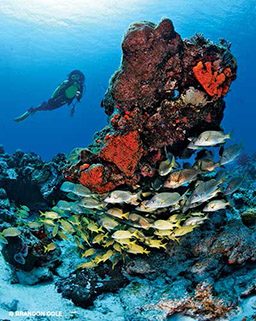
Colombia Deep is a crowd favorite. Coolness all around, indeed: There’s crystalline 120-foot visibility, a sheer wall disappearing into the abyss, coral-covered spires thrusting upward and innumerable sponges, sea fans and shimmering fish. The current moves us steadily along as countless photo ops whizz by. No worries; we know to go with the flow. We drop to 110 feet then ride the ocean thermals back up to 70, where Alex leads us into a jagged split to the reef’s heart. We swim through twisting tunnels and tight passageways into a large chamber. I capitalize on the dramatic architecture by shooting from the dark out toward the light. It makes for powerful compositions with divers silhouetted against the blue, surrounded by menacing, encroaching blackness.
Colombia Shallows or the adjacent Palancar Reef complex are often follow-up dives when you’re down in the southern reaches. But with the seas picking up in the stiff breeze, we pencil in these sites for later and turn north to motor halfway home, to Tormentos. Mark promises color and current at this intermediate site, and he’s right on both counts. The reef’s profile resembles the crenellated battlements of a castle wall — up and down, up and down, one riot of color after another in 10- and 20-foot-high blocks. Fingers and blobs of red, yellow and orange sponges decorate the reef heads, giving the appearance of bubbling, flowing and pooling lava.
Tormentos is awhirl with life. Our drift along its ramparts at 50-60 feet is like spiraling through a kaleidoscope. Fish sometimes cruise with us and sometimes explode backward in the opposite direction. There are rivers of snappers and grunts. Angels and damsels flit about. Sea fans stretch into the current, their branches forming hungry hands poised to grasp passing plankton. A sneering barracuda launches out of a crevice to photobomb my carefully composed picture. It startles me so completely that I lose my footing in the current and am swept away to the next coral head, where I tuck in behind the formation to set up another shot.

The Spice of Life
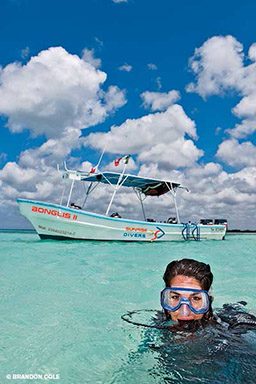
“Today we’re going to mix it up: steep and deep, shallow and mellow, colors that will pop your eyes out and maybe a surprise or two. Onward and downward! You’ll love it — trust me,” Mark says. I don’t know what all this means, but I trust him. I’ve followed his lead before, and good times were had.
The hull slices through calm blueness. The captain names dive site after dive site as they slip past underneath us while we motor along Cozumel’s coastline. Millions of visitors to Mexico’s Yucatan Peninsula think the only place to be is Cancun or Playa del Carmen, partying it up on the mainland 12 miles to the west of us. But they’re wrong. I longingly stare down into the blue below; this is where the action is.
“And here’s Maracaibo.” My head snaps up. Unless Mark is lying, we’ve reached reef’s end, the southernmost corner of the island. Maracaibo is exposed. Some days it’s Victory at Sea out here but luckily not today. There’s no swell and no wind. Mark smiles hugely. “What did I tell y’all? The sea gods are looking out for us. Let’s do this.” My wife and I do our buddy check and then backroll over the gunwale, plummeting down to join Mark and Alex.
Three eagle rays swoop gracefully by on the sea wind, just a bit too far away for photos. I’ve read that reef sharks are also seen here and even the occasional manta. Our lean nitrox mix allows us to descend to 130 feet, where we drift for a moment, past deepwater gorgonians and black coral bushes. We surprise a large grouper hiding under a ledge, and then as a team we angle upward to swim through a 30-foot-wide natural archway at 120 feet. It’s a very impressive formation, but I don’t have time or the right lens to do it justice. I honestly didn’t think we’d be fortunate enough to see this. Continuing up the wall we crest the edge, which is decorated with a vibrant assortment of hard and soft corals, a few golden crinoids and, of course, the ubiquitous Technicolor sponges. Sea rods bow in the current. Horse-eye jacks parade in front of us. A large free-swimming green moray snakes along behind us. Sadly, it’s time for us to take our leave and ascend.
Maracaibo is an advanced dive, because of the depth (the top of the wall is at 90 feet, and it drops precipitously to 150), sea conditions (big swell and strong winds are common) and current (it can really crank down there — no joke). Respect this site.
After a leisurely surface interval and an animated discussion of Hurricane Wilma’s punishing visit to Cozumel in 2005 (from which both topside and underwater communities recovered remarkably), we meander north to the C-53 Shipwreck. Coz is not a wreck-diving destination, but we can’t skip a chance to experience the local heavy metal scene. Resting proudly upright on the sand at 75 feet, this 184-foot Mexican Navy gunboat’s full name is Felipe Xicotencatl C-53. It was intentionally sunk for divers in 1999. Everyone can appreciate an easy dive around the ship’s exterior, and those with wreck training can follow an experienced guide to view some of the vessel’s numerous interior compartments. The C-53 makes for a good intro to wreck diving (it was well prepared for penetration dives) and is the focal point for Cozumel operators who offer wreck-certification courses.
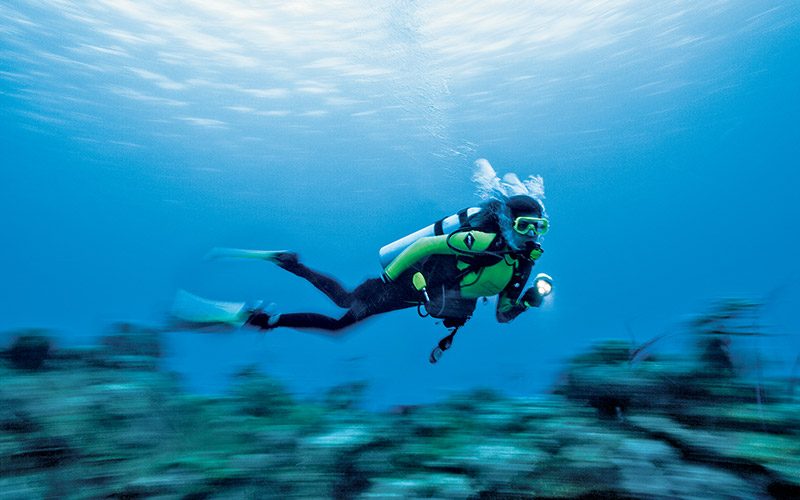
City Under the Sea
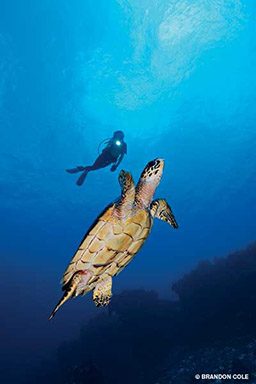
Many of the best reefs along Cozumel’s leeward shore are very complex structures — extraordinary three-dimensional seascapes that feature everything from coralline towers bisected by sand chutes to walls riddled with caves to mazes of pinnacles and mounds. There are coral terraces, canyons, spurs, fissures, amphitheaters, tunnels … you name it. It’s a topographical free-for-all, the intricate and imaginative work of time and tide. The end result is a veritable undersea metropolis in which every nook and cranny is home to one form of life or another and each pathway leads you to new discoveries.
Punta Sur is famous for two deeper attractions, the vaulted “Cathedral” chamber at around 100 feet and the “Devil’s Throat” vertical passageway from 90 to 130 feet. Santa Rosa features a bewildering network of swim-throughs as well as sand alleyways between soaring coral columns. Its fascinating Swiss-cheese reef system lured us back for a second dive. Critter watching was also productive here, with sightings of a bright yellow coney, two queens (angel and triggerfish), parrotfish and another toadfish. At Palancar Bricks one is likely to encounter hawksbill sea turtles. We saw three between 50 and 80 feet, including one napping on the bottom and one snacking on a barrel sponge growing on a miniwall.
Paso de Cedral boasts schools of porkfish and grunts nestled up against knobby reef protrusions draped in invertebrates as well as groupers, eels, lobsters, gray angelfish pairs, southern stingrays and nurse sharks. It’s a top choice for fish photography with a macro or wide-angle zoom lens, but be prepared for brisk current. After 60 solid minutes exploring Cedral, we inflated our surface marker buoys and kicked back to a relaxed safety stop and photo-chimping session, smiling at each other and reliving the dive while the boat matched our pace overhead.
Warm Currents
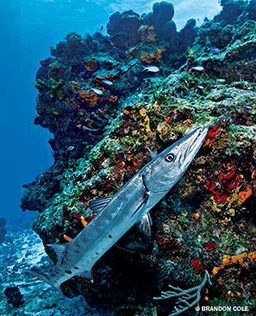
Underwater and above, it’s hard not to smile in Cozumel. Whereas we’ve occasionally been met with brusqueness and boredom by tourist-weary locals in other parts of the world, the Cozumelino welcome given us in San Miguel felt entirely genuine. “Casual, comfortable, and auténtico,” Mark quips, leading us down streets lined with colorful shops and inviting restaurants. We enter a courtyard full of happy people, visitors as well as natives, mingling under blooming flamboyant trees while a mariachi band entertains in the golden afternoon light. “¡Hola!” someone calls out to us. “How was the diving today?”
Mark beams, “See? This is a diver’s town, no doubt about it. The community wants our business, and the people are kind enough to share their culture — yet another reason why Coz grows on you, quickly becomes an old friend. You’ll be back before you know it!” Indeed, we’ve only been here a few days, and we’ve already fallen under its charm. Our Texan tour guide continues, “Hey, are you ready for dinner? The real deal? I’ve got the perfect place. Wait ‘til you taste the food! I’ll introduce you to some of my dearest Cozumeleño friends. We’ll eat, drink and be merry. And we’ll plan tomorrow’s dives!”
Smiling, we glide along behind him, going with the flow, carried on Cozumel’s warm currents. Coolness all around.
How To Dive It
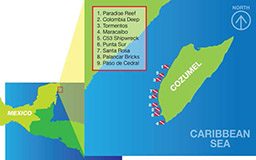
CONDITIONS: Cozumel is a year-round diving destination. Water temperatures range from 75°F to 85°F seasonally. Topside temps average 80°F year round. May to October is the rainy season, which often means afternoon showers. Water visibility is generally excellent, ranging from 75 to 125 feet at most dive sites. Current is almost always present, but varies between gentle to strong. Live-boat diving is the norm. Carry a surface marker buoy, and follow your guide. Dive sites to the far north, far south and the few frontier sites on the island’s rarely visited windward (eastern) side often feature rough seas and challenging conditions.
GETTING THERE: Select U.S. carriers fly directly into Cozumel (CZM). Many airlines serve Cancun (CUN). If arriving at CUN, you’ll need ground transport to the ferry terminal and passage across to Cozumel via ferry.
© Alert Diver — Q2 Spring 2014